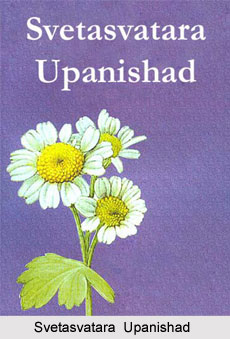 Svetasvatara Upanishad is one of the older, primary Upanishads that is familiar with the technical terms of the Samkhya philosophy and the Yoga philosophy. The Svetasvatara identifies the two, the personal and the impersonal and it makes the personal the creation of the impersonal Brahman. According to it as long as the individual clings to his own individuality, the absolute is other and so a personal god. But when the individual surrenders his individuality, the two become one. The third chapter of Svetasvatara Upanishad has twenty-one verses that describes about the Brahman.
Svetasvatara Upanishad is one of the older, primary Upanishads that is familiar with the technical terms of the Samkhya philosophy and the Yoga philosophy. The Svetasvatara identifies the two, the personal and the impersonal and it makes the personal the creation of the impersonal Brahman. According to it as long as the individual clings to his own individuality, the absolute is other and so a personal god. But when the individual surrenders his individuality, the two become one. The third chapter of Svetasvatara Upanishad has twenty-one verses that describes about the Brahman.
1st -5th Verse
As per the first verse the non dual Ensnarer rules by His powers. He remains the same all through and rules by His powers all the worlds during their manifestation and continued existence. The Rudra is truly one as the knowers of Brahman do not accept the existence of a second. He dwells as the inner Self of every living being. After he created all the worlds, He, became their Protector and then later takes them back into Himself at the end of time. His eyes, faces, arms are everywhere. He it is who endows men with arms, birds with feet and wings and men likewise with feet. He remains as their non dual manifester. He is regarded as the creator of the gods and the bestower of their powers and the support of the universe. He in the beginning gave birth to Hiranyagarbha.
6th - 10th Verse
The Supreme Lord is higher than Virat, beyond Hiranyagarbha. He is immeasurable and remains the bodies of all living beings. A person who becomes aware of this becomes immortal. By knowing the great Purusha, who is luminous, like the sun does one pass over death. They become immortal.
11th - 15th Verse
All faces are His faces; all heads, His heads; all necks, His necks. He dwells in the hearts of all beings. He is the all pervading. He is the omnipresent and benign Lord. He, indeed, is the great Purusha, the Lord of creation, preservation and destruction, who helps in attaining the state of innocence. He is the Ruler and the Light that is immortal. The Purusha is the inner Self, seated in the heart of man. He is known by the mind, which controls knowledge and is perceived in the heart. This Purusha with a thousand heads, a thousand eyes, a thousand feet, compasses the earth on all sides. He is also the Lord of Immortality.
16th -21st Verse
These verses state that the Purusha is everywhere. His hands and feet is present in all places. His eyes, heads and faces are everywhere; His ears are everywhere; He exists compassing all. He shines through the functions of the senses. It grasps without hands, hasts without feet, sees without eyes, hears without ears. It knows what is to be known, but no one knows it. This Self, smaller than the small, greater than the great, is hidden in the hearts of creatures. The wise, beholds the Lord and becomes desireless. He thus becomes free from grief.



















